Mora Garberg Review.
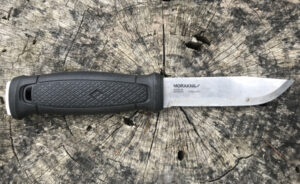
In this Mora Garberg review, I put it through its paces and see how it performs. The Garberg is a fixed blade knife with a full tang and Scandi-grind profile.
The Mora (Morakniv.) Garberg is available in carbon steel and stainless.
I ordered the stainless steel blade as I wanted to use it around the coast when foraging and for fishing. Long exposure to saltwater can be an issue with some carbon knives, so I chose the stainless version for less maintenance around the water.
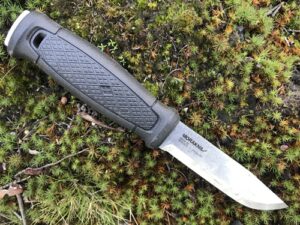
Before I wrote this knife review, I have had the Garberg for over eight months. I have occasionally used other knifes during that time, but tried to keep the Garberg as my primary knife to give it a fair test.
Initial impressions out of the box.
Before we get to the knife field test and the specs, my initial thoughts out of the box was that it was a solid, quality knife.
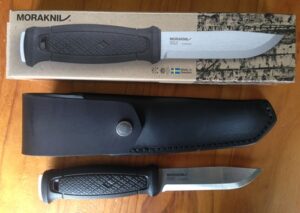
The blade was pretty sharp without touching it up. It shaved my forearm hairs easily and a lot sharper than a lot of knives out of the box new.
The handle was firm, but it felt perhaps a little weird with a hard plastic and rubber material feeling. The palm swell fitted my hand well.
A black leather sheath was included. It looked well designed, with both rivets and stitching.
The balance point of the Garberg was about an inch (25 mm) back on the handle from where it meets the blade.
It looked a good size knife for general woodcraft and camping tasks.
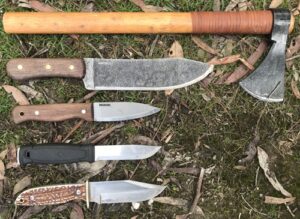
Above for size comparison: Cold Steel Frontier Hawk Tomahawk 18”, Hudson Bay knife, Condor Bushlore knife 9 ¼”, Mora Garberg 9″, Schrade Uncle Henry Next Generation Bowie Knife 9.375”.
To check out the top bushcraft knives, click on – Best Bushcraft Knives For Under $100.
The Garberg Stainless Steel Knife Specs.
Total length: 9.0 inches (229 mm)
Blade length: 4.3 inches (109 mm)
Blade thickness: 0.13 inches (3.2mm)
Blade material: Sandvik Swedish stainless steel 14C28N. (For the carbon steel, 59-60HRC)
Blade design: Scandinavian grind profile. Or Scandi-grind for short.
Spine: Square-edged ground spine.
Knife handle: Polyamide.
Mora Garberg weight: 9.6 oz. (272g)
Sheath: Leather, poly sheath, or multi-mount sheath system.
The multi-mount sheath can be attached to a vehicle, boat, etc. Or use the plastic poly sheath and attach it to your belt.
The multi-mount is MOLLE compatible. (Modular Lightweight Load-carrying Equipment.)
Made in: Sweden.
Tang: Full tang design.
What does it mean that the Mora Garberg is a full tang knife?
In a full tang knife, the blade runs all the way through the handle. The full tang makes the knife more durable and stronger, as opposed to a small bit of steel inside the handle. Like a partial tang or rat-tail tang.
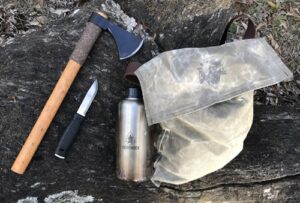
Above pic: Tomahawk, Mora Garberg, Pathfinder water bottle and Campcraft Outdoors haversack.
The Morakniv Garberg Field Test.
Disclaimer – For the field test, I probably treated the knife how I normally would use a knife, but perhaps more rough on it, to give it a fair test.
I didn’t hit it with a sledge hammer, or alternatively handle it with kid gloves and put it in cotton wool and not use it.
The handle.
The handle was comfortable, even after a lot of work with the knife, the handle felt good.
A chequered or rhombus pattern is in the handle. If you like a tactical look, then the black handle looks nice.
The handle wasn’t slippery when the knife was wet.
(I would say I like the feel in my hand of the Mora Companion Heavy Duty MG knife handle a bit better. But a very trivial personal preference. The Mora Campanion HD is one of Best Bushcraft Knives For Under $100 as well as the Garberg knife listed in this review as well.)
The handle has a lanyard loop hole in it which also goes through the tang of the knife. I didn’t test a lanyard out, or put one on the knife.
Fire-lighting with the knife.
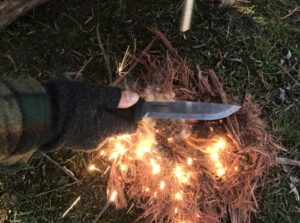
Ferro rod with the spine.
The knife spine is designed with striking a ferro rod in mind. As it has a very square spine, which has a burred edge deliberately ground for this purpose. Well done Morakniv for this design feature!
I tested it with three different brands and sized ferrocerium rods and it made some very nice sparks.
The spine was probably one of the best knives I have used for creating sparks with a ferro rod, like an excellent scraper. (Ferrocerium rod striker.) I would probably say, it was even better than a dedicated ferro rod scraper.
The pommel is also burred and can be used with scraping a ferro rod.
Friction fire.
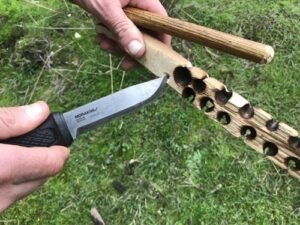
I used the knife to carve a divot and notch in a hearth board for a bow drill. The point was nice and not too wide to use.
The knife also carved and shaped some spindles easily.
General field use and profile.
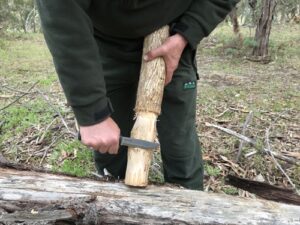
Using the Garberg for overall duties like, cutting cordage, shelter building, making tent stakes, fashioning tripods, carving notches for traps, etc., was fine and I enjoyed using it.
For finer detailed carving, the thick 3.2mm blade makes it a bit more difficult to use. So what you gain for in strength and robustness from the blade and Scandi-grind, you are going to lose in finer carving work. There is always a trade-off.
Matching the grind profile / design / thickness for what you are going to mostly use the knife for is key, for getting the most out of the knife.
In my case the blade profile was ideal for the majority of my general field-craft and bushcraft use.
The Garberg excels at general woodcraft use, with the confidence it is robust, while still being a practical size.
A burred edge on the Garberg spine can also help scrape wood off for tinder.
If you were fine carving all the time, field dressing a lot of game, the Scandi-grind profile would not be the best choice. But for general bushcraft, it is a great tool and well designed for that particular use.
Pommel.
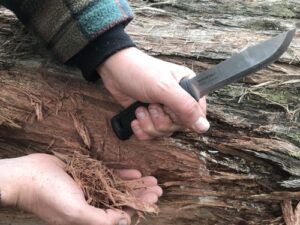
The pommel was handy for scraping bark and wood for tinder. It was pretty useful for me and when I did switch over to other knives, I did miss the pommel on the Garberg.
The pommel could also be used for a hammer to crush nuts, process cordage, or breakdown shells, etc.
The “B” word. The batoning test.
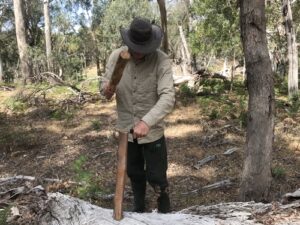
Yes, I did baton the knife. And I enjoyed it! (I hope I didn’t offend anyone.)
In my area, even in the wet I can generally find plenty of dry twigs and fire wood. So I don’t have too realistically baton anything to get dry kindling or splints. However, I like to test the knife out fully, and I do appreciate batoning a good solid knife.
I batoned some twisted grain hardwoods with it of different lengths and thicknesses. Not huge log size diameter, but around forearm to bigger upper arm size branches and assorted woods.
The full tang knife and thick blade performed well batoning the wood.
Feather sticks. Oh dear!
As mentioned the grind and thicker blade makes it a bit more trying to do fine delicate work, however with a bit of control, I could fashion some feather sticks.
But I have come to the humbling conclusion, that my feather sticks suck badly and I could use a lot more practice doing them.
The knife is fine for feather sticks, but my skills not so. It also helps to have long straight grain, softer wood which makes it easier to create better feather sticks.
Chopping.
The knife chopped okay for its size, weight and limitations for chopping. Obviously it isn’t an axe, or a big heavy weight forward blade.
For delimbing some small limbs I wished the blade was a touch bigger, but the knife isn’t a chopper and can’t be everything.
The Morakniv Garberg sheath.
The sheath retains the knife by a flap over the top of the handle and pommel. A press stud holds the knife flap down securely.
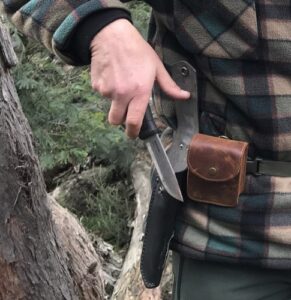
The retention flap can get a little bit annoying if you are constantly getting the knife in and out of the sheath. But I think I was used to getting knives out of a friction pouch sheath, (Without the press stud.) such as an example, a Condor Bushlore sheath.
As the flap goes over the top of the knife and the press stud or snap secures the knife, it is probably slower getting the knife out and in. Then say using a horizontal retaining strap around the knife handle. However, it does give you confidence that the knife will stay secure in the sheath.
The stitching and riveting was solid and the sheath held up well over the eight months with minimal sign of wear.
The sheath leather probably wasn’t as thick as leather as some sheaths, but seemed like a quality sheath.
I taped a sail needle and nail on the back of my sheath, as these items can be handy and take up no space.
I will probably end up ordering the plastic sheath for when I use it more for around waters fishing and foraging. (But dam, leather sheaths do look nice.)
Edge retention.
Sharpening (Stropping and maintaining it.) the knife regularly, is a better idea then only occasionally sharpening it. However, I deliberately tried not to sharpen it for a while, to see how the knife blade held up.
Sharp, sharp and sharp, the knife retained its edge well for a fairly long time. This was also after batoning with hard woods and general use.
Eventually there was some slight burrs on the edge and dull sections and I needed to sharpen it.
Oh, the Horror!
During one camping trip the youngest boy was practicing his fire-lighting skills with the ferro rod. I initially thought, well done, as he was getting some good directed sparks. I then reeled in horror, as I saw he was using the BLADE of the Mora Garberg to scrape the ferro rod!
I guess it was my fault for not emphasizing again, (And again.) use the spine of the knife, not the blade.
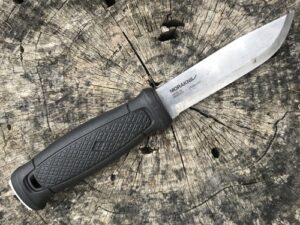
Sharpening the knife.
The Garberg has a Scandi grind that has a slight micro bevel on the blade.
I put the blade on a fine wet stone (Whetstone.) and it sharpened with a bit of work. I then used a leather strop and it come up sharp.
I would say it took a moderate amount of work to sharpen it. However, I did let it go past the point when I would normally sharpen it, purely for the test, so it took a bit more work.
Regular touch ups on a fine stone or stropping and the knife is good to go.
Negatives of the Garberg?
Initially, the price was the only real drawback I could think about the knife. But, I guess we are just used to seeing great quality Mora knifes, for an outstanding price like the Mora Companion HD, so my point is probably not valid.
The more I thought about the price of the Garberg and considered the good design of the knife, it is probably great value. Especially knowing that it will last many, many years.
(Below – Mora Frost knife. Further to that, my late farther has a Mora knife that was used as a fishing gutting knife. This knife has been used and abused for probably over 30 years and is still going strong with minimal maintenance. A nice rainbow trout caught by my son recently.)
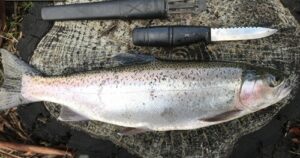
Back to the Garberg review, I cannot see any big negative points about the knife, only minor personal preferences, but nothing huge.
A tad bigger bottom hand guard or lower hilt, so there is no chance the hand slips down would have been nice in my opinion. You then could still use your thumb on the top of the spine for push cuts and controlled work, but have the safety aspect of a slightly bigger lower hand guard.
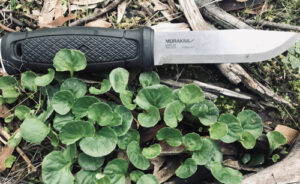
My wish list.
For my personal preference a nice tanned brown or walnut colored sheath would have been nice. (But it probably wouldn’t match the black handle of the Garberg.)
A wooden handle is hard to beat for aesthetics for a bushcraft type knife, although you probably can’t beat the modern rubber / plastic handles for durability and minimal maintenance.
Perhaps a pouch on the sheath for a stone would be nice, but then this is more bulk or cost for those who don’t need it or like it.
So to wrap up my wish list for the knife, a wooden brown handle Mora Garberg, brown leather sheath with a stone pouch on it?
Other Mora Garberg reviews.
For those people sitting on the fence whether to buy a Garberg knife or not, Paul Kirtley, David Canterbury (Pathfinder School and Self Reliance Outfitters.), Joshua Enyart (The Grey Bearded Green Beret.) and Survival Lilly have done nice reviews on the Garberg, on their YouTube channels.
(David Canterbury also worked with Morakniv on the design and feedback of the Garberg.)
Summary – Mora Garberg knife review.
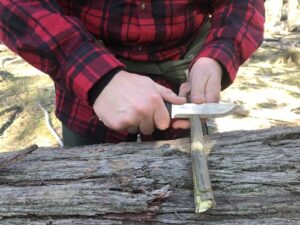
As expected with the Morakniv name, the knife performed very well in the field test.
The Garberg has a lot of options to choose from, with the stainless steel or carbon blade. As well as a choice of a leather sheath, poly sheath and multi mount system.
The full tang, quality steel, practical size and design, makes the knife a keeper.
I am a fan of Mora and this knife is solid. This is one knife that I will happily take into the woods as my primary belt knife.
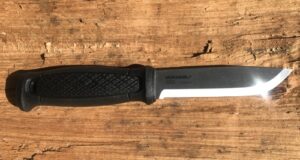
Whether for a dedicated bushcraft knife to help create tools, a general outdoors knife, or a pure survival knife, the Mora Garberg ticks a lot of boxes and is a well-designed, robust knife.
Thank you for your time reading this article, I hope you enjoyed the knife review.
What is your thoughts on the review or the Mora Garberg knife?
